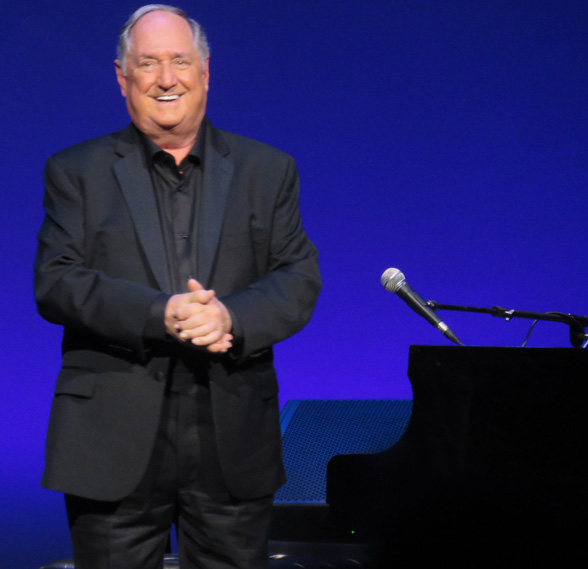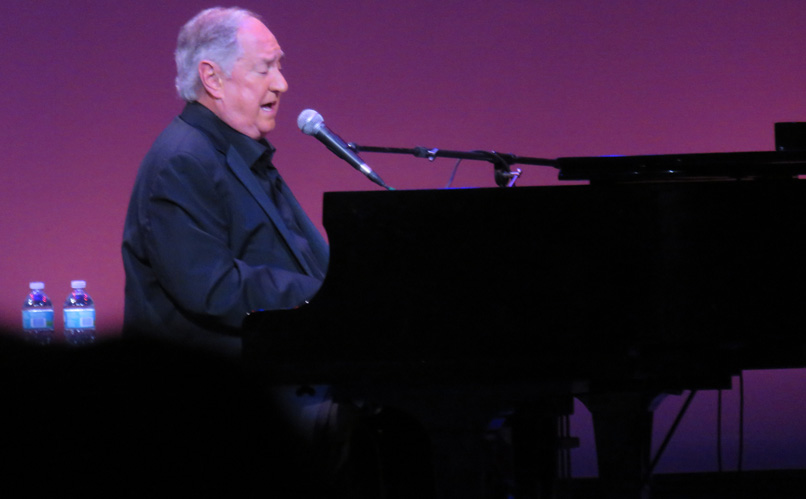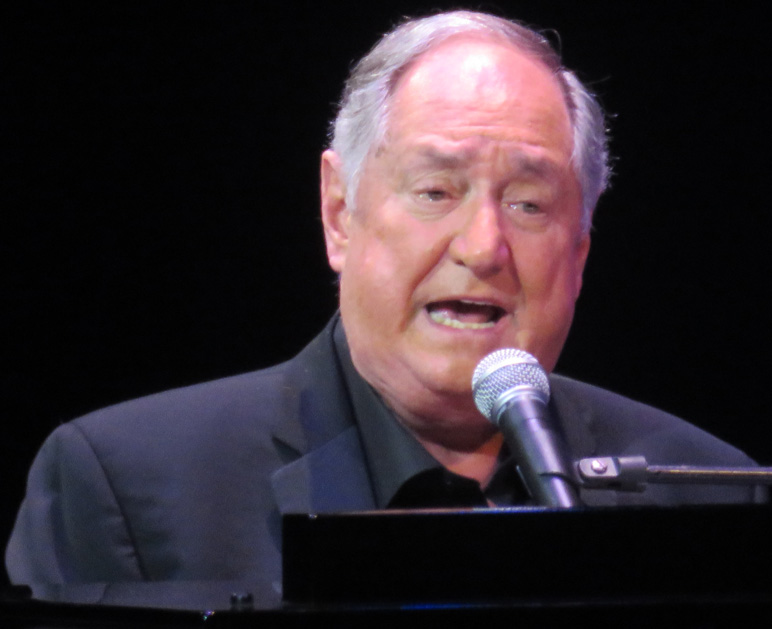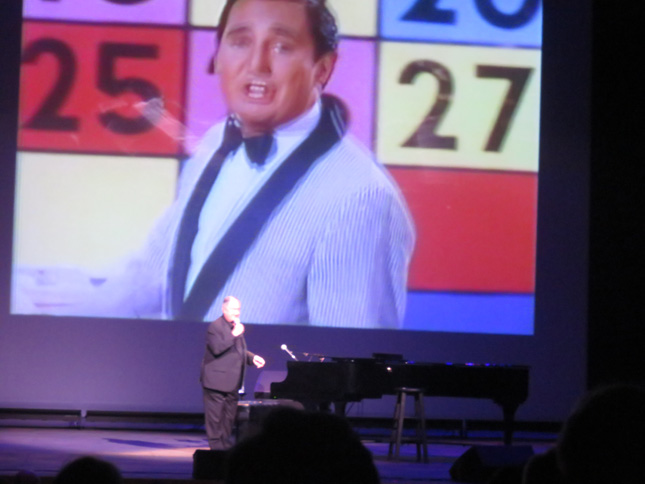Neil Sedaka seemed puzzled and bemused midway through his sellout concert Monday night in the Sharon L. Morse Performing Arts Center.
Sedaka, whose singing and songwriting career spans 60 years and nearly 700 songs, was having problems with his lengthy set list of music to perform.

“I have to keep looking at the list of all these songs,” said Sedaka, 76, alone on stage with only a piano and a couple of water bottles. “There are so many hits, I don’t know where the hell to start.”
Such is the challenge for one of the most influential songwriters and performers to come out of the 1950s rock and roll era.
From early hits, such as “Calendar Girl,” “The Diary” and “Oh! Carol” to later smashes “Solitaire,” “Love Will Keep Us Together” and “Laughter In the Rain,” Sedaka’s songbook seems as big as a telephone book.

The music of Neil Sedaka echoes throughout the past seven decades. His songs mark a cultural touchstone for a generation that came of age with Dick Clark and must now cope with Lady Gaga.
Every Sedaka song tells a story and he was happy to share tales of the old days with an adoring audience.
“I wrote this song for my girlfriend when I was in high school in Brooklyn,” Sedaka said. “Her name was Carol Klein. You know her as Carol King.”

Then, Sedaka started playing a piano riff with a kind of doo-wop, cha-cha beat on “Oh! Carol,” from 1959.The people in The Sharon loudly cheered, clapped and some sang along.
Sedaka was talking – make that singing — their language.
“Let’s go back to yesterday,” said Sedaka, who was in a chatty mood all through his 90-minute concert. “I came up with Dick Clark’s ‘American Bandstand.’ It was marvelous back in the ‘50s. You could actually understand the words to the songs.”

And Sedaka had his own, unique niche back in those golden oldie days. “I was the king of tra-la-la and dooby-dooby,” he said.
You want examples?
Sedaka sang his first rocking version of “Breaking Up Is Hard to Do” which begins with these lyrics: dooby-do-down-down.”
But wait, there’s more.
“Happy Birthday Sweet 16” starts rocking this way: “tra-la-la-la, tra-la-la-la, happy birthday sweet 16.”
Now, if Neil Sedaka had disappeared after those of Top Ten records, that’s the way we would remember him.
But the guy – and songwriting partner Howard Greenfield — had a magical way with music and lyrics and wrote hits for some of the biggest stars
“I put Fort Lauderdale on the map with this song, by the great Connie Francis,” Sedaka said. Then he hit the piano keys and started singing, “Where the Boys Are,” and before you knew it, all those aging Villagers in The Sharon felt like kids on Spring Break, circa 1960.
“How could I forget Neil Sedaka,” said Villager Anne Thomas. “I remember one summer, sitting on the beach in North Carolina listening to ‘Breaking Up Is Hard To Do’ all the time. Neil was great then and he’s still on target.”
Sedaka played a 1961 video of his jumping pop/rock hit, “Calendar Girl,” that featured a number of women dancing around him in skimpy bathing suits as he sang the song.
“A while back I was having lunch in Los Angeles,” Sedaka said. “A woman came up to me and said she was one of the girls in the video. She was an old, old lady,” he added as the crowd laughed. “Of course, I haven’t changed at all.”
Sedaka was a dominant force in the music world from 1958-64. He said he sold 43 million records in that period. Then his career took a dive, when something unexpected happened: the Beatles.
John, Paul, George and Ringo had long hair and a new sound. Singers like Sedaka virtually disappeared in the U.S.
“But they still loved our music in England,” Sedaka said. Finally, in the mid ‘70s, he hooked up with Elton John. “I was retired for 13 years and then I met Elton,” Sedaka said. “He told me he was going to make me a star all over again (on John’s record label). This is the song that brought me back.”
Sedaka then started singing, “Laughter in the Rain.” The glossy pop ballad was a big hit.
In 1975, he recorded another of his biggest songs, “The Hungry Years.” It was later recorded by Frank Sinatra, among many others, and Sedaka played and sang the number with a palpable emotion.
Then came another Sedaka classic from the ‘70s: “Solitaire.”
“This is the most covered song of all the ones I’ve written,” Sedaka said. He added that over 60 artists have recorded it, including Elvis Presley and the Carpenters. Sedaka softly played and sang the melancholy number.
Once again, there was a loud ovation and someone in The Sharon yelled out a request. “Hey Neil, play ‘Rosemary Blue,’ came a loud voice out of the darkness.
“I haven’t played that in 30 years,” Sedaka said, as he sat at the piano and tinkered with the keys. Then he started singing the ballad, with a classical piano flavor, It’s a song about love, life and death and Sedaka — like the people in the audience — was right back in tune with his past and the present.
Sedaka ended the concert in hard-rocking style with “That’s Where the Music Takes Me.” He left to a standing ovation and the fans didn’t want him to leave.
So Sedaka came back.
“I think I’m the only recording artist to have a hit record with the same song years apart,” Sedaka said. He offered a slow, powerful version of “Breaking Up Is Hard to Do” that became a hit all over again in late 1975. Sedaka turned the ‘50s’ rocker into a mature and deep romantic journey.
He left the stage but, once again, the audience stood and kept cheering. Sedaka returned for one more encore.
This time, it was a slow, autobiographical song; a personal statement why he is still performing.
“When I go out on the stage I seem to come alive,” he sang, in a gentle voice, teeming with introspection. “I’ll try to touch you with my soul….I’ll give my heart to you. I do it for applause.”
When it was over, Neil Sedaka left the stage for good.
And The Sharon resonated with applause.

